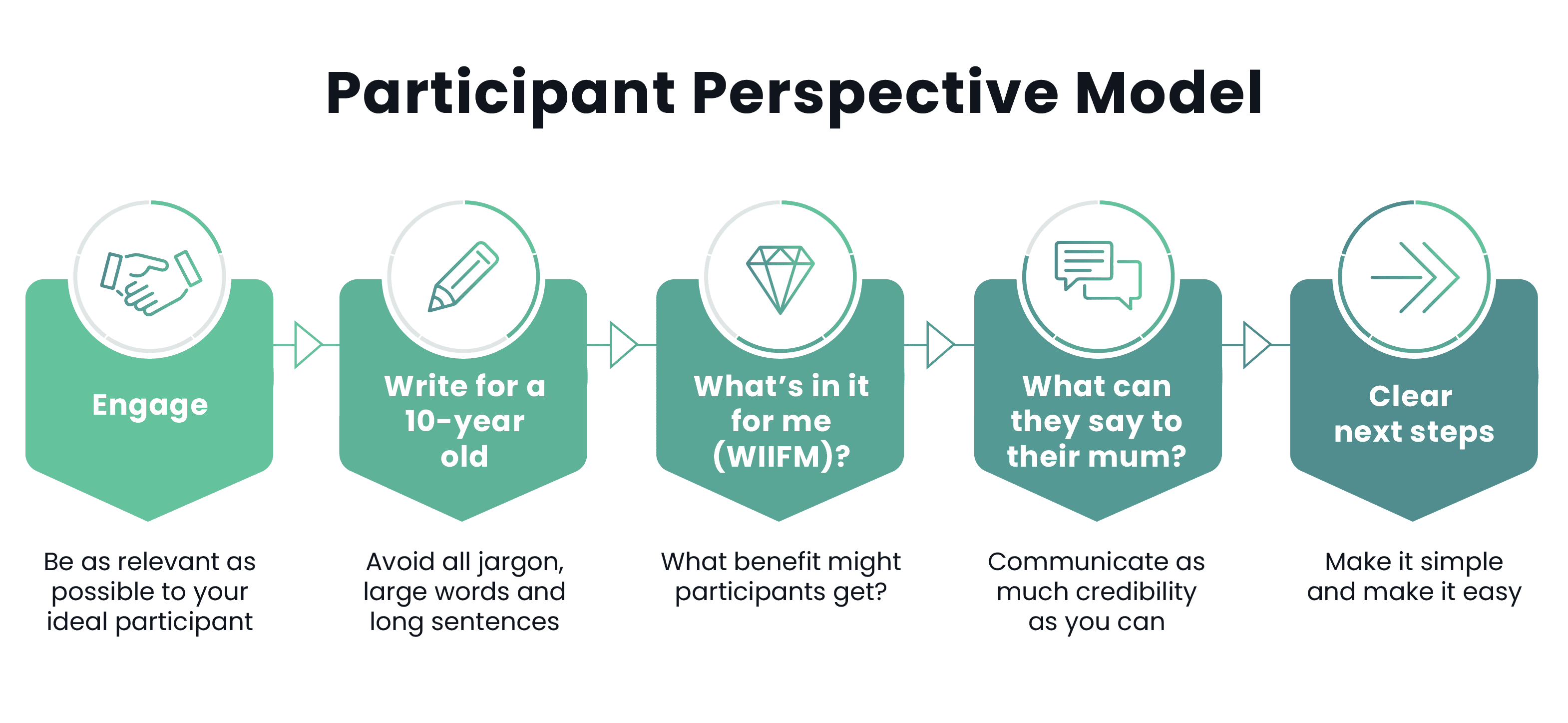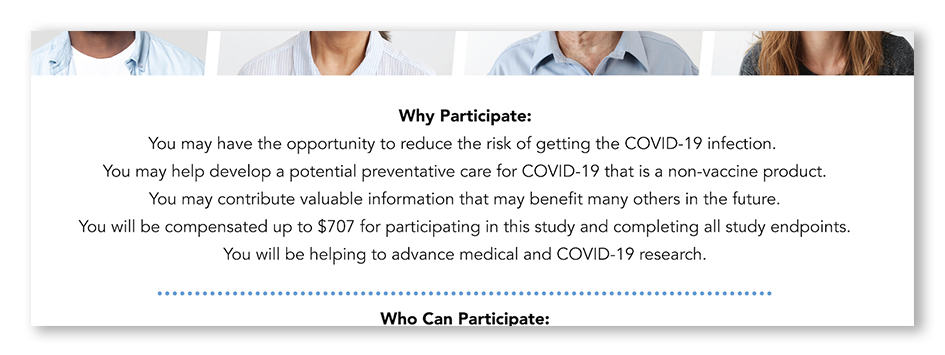Creating an effective research flyer to attract and recruit ideal participants to your clinical research study is harder than it seems.
At any given moment, we have unlimited amounts of information at our fingertips and everything seems to be vying for our attention.
That said, it’s no wonder why so many research studies struggle to reach, recruit, and retain study participants.

As studies continue to suggest that our attention spans are declining, crafting an enticing research recruitment flyer can be immensely beneficial to the successful completion of your clinical trial – that’s a given.
The problem is that many researchers don’t realize why their recruitment flyers don’t work and why their recruitment attempts ultimately fail.
If you’ve never put much thought into how to market effectively to your ideal participants, you’re not alone. Most researchers don’t focus on direct marketing because it’s simply not their area of expertise (and that’s okay!).
Be that as it may, it doesn’t change the fact that your “old, tried-and-true” way of designing research study flyers isn’t working well. (And, for the record, your colleagues’ flyers aren’t performing any better than yours.)
Again and again, study findings suggest that researchers consistently overestimate potential participant numbers and that as much as 50% of a research study’s timeline can be spent on recruitment alone. In a world that moves at lightning speed, you can’t afford to lose precious weeks or even days simply trying to recruit participants for your study.
It’s time to ditch ineffective systems and find a new gold-star standard. In this article, we’ll cover the hard truth about research flyers – why most of them don’t work and what you can do about it.
Most importantly, we’ll teach you a no-nonsense process using our Participant Perspective model to help you make more effective participant recruitment flyers and other recruitment materials.
Why your study recruitment flyer isn’t working
Then, you waste money by producing ineffective research flyers and marketing materials.
Ultimately, you risk netting fewer participants than you hoped you would.
Marketing incompetence – whether conscious or unconscious – compromises your research.
You can do “all the things” you can think of and still not find enough participants if you don’t understand how to create strong, enticing research flyers and clinical trial marketing materials.
To make up for lost time and money, you may accept a lower sample size for your clinical trial. This leads to having less robust data and results.
“Whether they’re consciously or unconsciously incompetent about their marketing skills, the last thing any researcher wants to do is waste time or money when recruiting for a clinical trial.”
You may change your prescreening eligibility criteria to make it easier for people to participate. In other words, you cut corners in your own study to make participants “fit” that otherwise wouldn’t.
You may opt to drastically redesign your study by cutting out or toning down invasive (yet important) procedures or require fewer study site visits.
Making changes like these to your clinical trial plans gravely compromises your research and your study timeline.

The key point: You can do all the “right things” and still have little to show for it.
Let’s consider the fictional (yet realistic) story of “Andrew,” a clinical researcher at a well-respected university. Andrew would regularly spend a significant amount of time – up to 50% of a study period – attempting to recruit participants for his and his PhD students’ studies.
Andrew and his students would consistently “pound the pavement” and put up dozens of flyers around the university campus, in local coffee shops, and at transit stops.
No matter what he did, however, it always seemed like he had little response for his efforts or, when he did get a positive response, most participant applicants turned out to be ineligible for his or his students’ studies.
At other times, participants who were eligible often decided to drop out of the study once they learned what was required, such as necessary but invasive procedures or the number of required in-person clinic visits.
“Andrew’s” story isn’t a unique one: This recruitment flyer circus is tiring and frustrating, and yields few positive results. Though you and your peers may feel the same way and take solace in your shared frustrations, the fact remains that trial recruitment doesn’t have to be this way.
Remember, it takes a lot to grab someone’s attention these days.
We live in a world of ceaseless advertising noise. Recent estimates suggest the average American is bombarded by as many as 10,000 advertisements in a single day. As a result, we’ve learned how to tune out the excess “noise” around us and are rarely attracted to brands or companies we don’t recognize.
As a researcher, you’re likely also familiar with the increasing competition for participants. There are a growing number of studies aiming to capture eligible participants’ eyes. Studies are also becoming more complex and asking for more participants (and more from them).
With so much competition for our attention – and not just from other studies – it’s exceedingly difficult to stand out.
In essence, your research recruitment flyer has to be more than just enticing – it has to be practically show-stopping.
And while creating a recruitment flyer seems fairly straightforward, there’s a lot involved to getting inside the head of your ideal participants. Copywriting, visual design, marketing, and advertising all play crucial roles.
Developing effective research recruitment flyers calls for a completely different skill set and often requires many years of study and experience to get good at doing it.
“Unless a particular researcher has an advertising and marketing background, they should be focusing on what they do best, and look at hiring an expert.”
How to create an effective research flyer
As a clinical researcher, you may not have the set of skills necessary for stellar marketing and advertising. That’s okay – you still have tools at your disposal to help you craft an enticing and ultimately successful research flyer.
The main things to consider when designing a flyer are verbiage and appearance. For a moment, turn off your “researcher brain” and instead, consider how your potential participants think. We like to connect this process with the old adage of “walking in someone else’s shoes.”
In this case, you’re walking in your participants’ shoes.
Our Participant Perspective model makes this easy.

Engage your audience.
Be as relevant as possible to your ideal participant. It’s a good idea to think about the patients you interact with on a daily basis. How do they communicate their symptoms and how do they respond to your recommendations?
These interactions will help you better understand who your recruitment flyer is “speaking” to.
Write for a 10-year-old.
Yes, you read that correctly! This may seem ridiculous but it’s arguably the most important part of creating an effective research study flyer or poster.
Your participants are not medical professionals – they’re everyday people with jobs across dozens of industries. They don’t know medical terms or use clinical jargon to describe their troubles.
When writing the content for your flyer, avoid any use of industry jargon, large words, and long sentences. Keep it simple. Mention struggles or symptoms participants may experience in clear language that a child might use.
Consider the big WIIFM (“what’s in it for me?”) questions.
As humans, we’re all extrinsically and intrinsically motivated in some way.
Using that clear language, point out what benefits your participants will get in return for their time and participation. Whether you’re offering monetary compensation or simply want to communicate the positive impact your participants will have, people need to know they’re getting something out of this experience.

Help potential participants communicate their impact to others.
Again, this goes back to using language that any participant can both understand and relate to.
Think of it this way – what can participants say to their mom about participating in your study?
No one wants to feel like a “human guinea pig.” Help participants answer basic questions about your study. For example, prepare them to clearly explain the reason the trial is being conducted and their role in it to anyone who may ask. Can they share what answers you hope to find through your research?
Additionally, ensure that your participants know the study is being conducted by a reputable university or hospital and that it’s been approved by an independent ethics committee. Let them know their participation is fully voluntary and that they can withdraw from the study at any time.
Make it easy to sign up for prescreening.
Make the next steps clear and simple. In fact, make them big.
Do participants need to call a phone number? Make that phone number a focal point.
Do they need to complete an online screening questionnaire? Make that web address easy to find and remember. Avoid using really long and hard-to-type URLs. (And while we’re at it, use hyphens to separate words. This is easier to read, type out, and understand.)
If you’re using an online questionnaire, make sure it’s mobile-friendly. Half the world’s web traffic now takes place on mobile devices like smartphones.
Bottom line: Make the next step as easy as possible with low barriers to apply.

Revisiting “Andrew” the Clinical Researcher
Let’s revisit Andrew.
After learning of the Participant Perspective model, he realized his recruitment flyers were leaving a lot to be desired. They didn’t look particularly professional and didn’t convey much credibility or legitimacy. Additionally, Andrew recognized the photos they often chose were also not very relevant to the audience they were actually targeting.
After using the Participants Perspective model to create a basic research flyer, Andrew and his students began seeing upticks in their recruitment efforts. They were getting more inquiries and were able to spend less time on recruitment overall.
Andrew knows that the vast majority of flyers are pretty terrible and now notices them everywhere. He’s amazed that they are written completely from the researcher’s point of view. Seeing these flyers has helped him realize why his own past flyers were so ineffective.
Consider Plan B: Don’t do it yourself
According to data, 85-90% of studies are delayed due to poor enrollment.
You may have been creating the same kind of flyers for years, and maybe they used to work. But with the growing competition for study participants and our attention being pulled in so many directions, their effectiveness has dwindled.
If you’re looking at our Participant Perspective model and thinking, “This is a ton of work and I’m already busy,” we understand.
It is a ton of work and it does take a lot of consideration to make a great recruitment flyer.
This is why many researchers have discovered that hiring an expert to help them is a far better use of their budget and time. By leveraging a marketing specialist’s expertise, you can leverage yours.
With the help of an experienced marketer, you set yourself up for success so you can deliver world-class research. You’re far more likely to stay on track, make progress, and be able to do what you do best – focus on the research. You’ll feel far more in control, organized, and energized.

There’s good reason to make an educated change to your clinical research recruitment flyers.
As a researcher, you know there’s more competition than ever for clinical trial participants and there’s a consistently growing number of studies. Studies are also becoming more complex and asking more of participants.
It’s hard to get anyone’s attention these days thanks to the inundation of advertisements.
People see literally thousands of them in a single day. Not only that, but thanks to the availability of digital media, we rarely look up from our screens enough to take notice of something like a research flyer. This makes it all the more difficult to cut through the noise and reach your ideal participant.
Most research flyers are poorly designed and the researchers who create them suffer from unconscious incompetence – they don’t know their flyers are ineffective or they don’t understand why they’re ineffective.
If recruitment doesn’t go well, you may be tempted to make some tough decisions, like adjusting your study requirements which could lead you to compromise your research.

Creating effective research flyers and posters requires a “walk in your participants’ shoes.” When creating study promotional materials, including the 5 must-haves from our Participant Perspective model will set you up to design a successful flyer.
Ideally, hiring a marketing specialist could make a world of difference in your recruitment efforts.
Leveraging their experience allows you to focus on the research and your study’s trajectory rather than recruitment woes. You can finish on time (or ahead of schedule), develop a better track record, and do more important work.
Finding the right help for your research recruitment
As you prepare your next research recruitment flyer, use our Participant Perspective model to “walk in your participants’ shoes.” You may be surprised at your improved recruitment results.
To save both time and money (yes, save money!), get some help from experienced marketers from the start.
Trialfacts offers specialized recruitment services for clinical and other research studies. Instead of spending your limited budget on creating recruitment flyers that don’t work, enlist the help of a specialist to ultimately preserve your funds.
Don’t waste time trying to get it right on your own.



